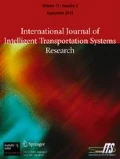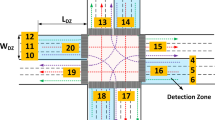Abstract
To optimize the traffic signal control of isolated intersections, a hybrid colored Petri net is proposed to model the urban signalized intersection, which consists of a traffic signal control module and a traffic flow module. Furthermore, a new feedback-based signal control method based on the Petri net model is presented. The method performs an online optimization and synchronization of traffic signals. After finishing the minimum green time of current phase, whether extending the current phase’s green time is determined by comparing a performance index of the current phase with the candidate phases. The performance index is based on the number of queued vehicles and the red time of candidate phases. Finally, experiments on field data are carried out against the fixed time-of-day control strategy to compare their performances on average vehicle delay. Results verified the feasibility of the Petri net model and the effectiveness of the proposed method.








Similar content being viewed by others
References
DiCesare, F., et al.: The application of petri nets to the modeling, analysis and control of intelligent urban traffic networks. Application and Theory of Petri Nets 1994, LNCS 815, pp. 2–15. Springer Berlin, Heidelberg (1994)
Tolba, C., et al.: Continuous petri nets models for the analysis of traffic urban networks. Proc. IEEE Syst. Man Cybern. Conf. 2, 1323–1328 (2001)
Tolba, C., et al.: Performances evaluation of the traffic control in a single crossroad by petri nets. Proc. IEEE Conf. Emerg. Technol. Fact. Autom. 2, 157–160 (2003). ETFA '03
Kutil, M., and Hanzálek, Z.: Light controlled intersection model based on the continuous petri net. Proceedings of the 12th IFAC Symposium on Control in Transportation Systems, California, 519–525. (2009)
Jűlvez, J., Boel, R.K.: A continuous petri net approach for model predictive control of traffic systems. IEEE Trans. Syst. Man Cybern. Syst. Hum. 40(4), 686–697 (2010)
Di Febbraro, A., Sacco, N.: On modelling urban transportation networks via hybrid petri nets. Control. Eng. Pract. 12(10), 1225–1239 (2004)
Di Febbraro, A., Giglio, D., Sacco, N.: Urban traffic control structure based on hybrid petri nets. IEEE Trans. Intell. Transp. Syst. 5(4), 224–237 (2004)
Chen, F., et al.: A novel hybrid petri net model for urban intersection and its application in signal control strategy. J. Frankl. Inst. 351(8), 4357–4380 (2014)
Vázquez, C. Renato, et al.: Hybrid Petri net model of a traffic intersection in an urban network. IEEE International Conference on Control Applications (CCA), pp. 658–664. (2010)
Jbira, M.K., Ahmed, M.: Computer simulation: a hybrid model for traffic signal optimisation. J. Inf. Process. Syst. 7(1), 1–16 (2011)
Mladenovic, M. N., and Abbas, M. M.: Modeling ring-barrier traffic controllers using colored timed stochastic petri nets. IEEE Conference on Intelligent Transportation Systems, 243–248. (2010)
Li, L., et al.: Traffic signal priority/preemption control with colored petri nets. 8th International IEEE Conference on Intelligent Transportation Systems, 694–699. (2005)
Dotoli, M., Fanti, M. P., and Iacobellis, G.: validation of an urban traffic network model using colored timed petri nets. In: Proc. IEEE Int. Conf. Syst. Man Cybernetics, 1347–1352. (2005)
Dotoli, M., Fanti, M.P.: An urban traffic network model via coloured timed petri nets. Control. Eng. Pract. 14(10), 1213–1229 (2006)
Barzegar, S., et al.: Formalized learning automata with adaptive fuzzy coloured petri net; an application specific to managing traffic signals. Sci. Iran. 18(3), 554–565 (2011)
Huang, Y.S., Chung, T.H.: Modeling and analysis of urban traffic lights control systems using timed CP-nets. J. Inf. Sci. Eng. 24(3), 875–890 (2008)
Liang, Q., Zhou, M., Luan, W.J.: Emergency traffic-light control system design for intersections subject to accidents. IEEE Trans. Intell. Transp. Syst. 17(1), 170–183 (2015)
Ng, K.M., Reaz, M.B.I., Ali, M.A.M.: A review on the applications of petri nets in modeling, analysis, and control of urban traffic. IEEE Trans. Intell. Transp. Syst. 14(2), 858–870 (2013)
Webster, F. V.: Traffic signal settings. Road Research Technical Paper 39. (1958)
Gallager, R.G.: Stochastic processes: theory for applications. Cambridge University Press, Cambridge (2013)
Author information
Authors and Affiliations
Corresponding author
Appendix A
Appendix A
Part of records of green time length is shown in Fig. 9.
Rights and permissions
About this article
Cite this article
Zhang, Y., Qiang, W. & Yang, Z. A New Traffic Signal Control Method Based on Hybrid Colored Petri Net in Isolated Intersections. Int. J. ITS Res. 15, 98–107 (2017). https://doi.org/10.1007/s13177-016-0124-0
Received:
Revised:
Accepted:
Published:
Issue Date:
DOI: https://doi.org/10.1007/s13177-016-0124-0





